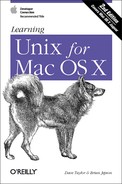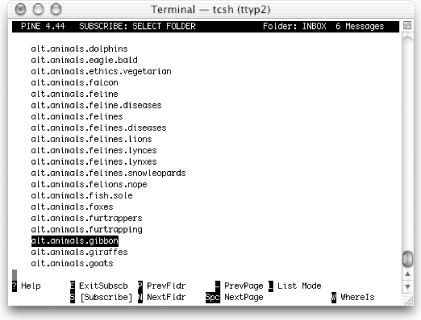Usenet, also called “Net News,” has thousands of worldwide discussion groups. Each discussion is carried on as a series of messages in its own newsgroup . A newsgroup is named for the kind of discussion that happens there. Each message is a lot like an email message. But, instead of being sent to a list of email addresses, a newsgroup message is sent to all the computers that subscribe to that particular newsgroup — and any user with access to that computer can read and reply to the message.
Tip
Because Usenet is a public forum, you’ll find a variety of people with a variety of opinions — some impolite, rude, or worse. Although most users are friendly and helpful, a few people seem to cause most of the problems. Until you’re accustomed to Usenet, be aware that you may be offended by some contributors and attacked (“flamed”) by others.
To read Usenet groups, you’ll need a
newsreader
program,
also called a news client. Many email programs
can read news, too. You can use any newsreader; the principles of all
are about the same. Some of the more popular Unix newsreaders are
slrn, nn, and
trn. We show how to read news with Pine Version 4.
If you haven’t used Pine before, please read Section 8.3.2 earlier in
this chapter.
Tip
To set up your copy of Pine to read Usenet messages, go to the Config menu (see Section 8.3.1, earlier in this chapter) and set nntp-server to your ISP’s or company’s news server. You will need to get the name of this server from your ISP or system administrator.
When you choose the L key
(“folder list”) from the main menu,
you’ll get a Collection List screen, as shown in
Figure 8-7. A
collection
is a group of folders. A collection can
be email folders from your local computer, email folders from other
computers, or Usenet newsgroup folders. Figure 8-7
shows two collections: Mail and News
on news.east.cox.net/nntp. The news collection is selected
(highlighted).
When you press Return or > to view that
collection, you’ll get a list of newsgroup folders.
If your News collection is empty, it means you have not subscribed to
any newsgroups. Press A
to add a newsgroup. You can
either type the name of a newsgroup if you know it, or you can press
Control-T to get a list of all newsgroups (press E
when you have selected a newsgroup from the list). If you are on a
slow link (such as a 56k modem), it could take a long time to get a
complete list.
Usenet has something for everyone!
The Pine D command will delete a newsgroup from
your list; it won’t appear anymore unless you use
the A command to add it back. (Pine also has some
advanced features, such as
“zooming” to a list of folders that
you’ve defined. See the Pine help system for
details.) Figure 8-8 shows a list of newsgroups.
Newsgroup
names are in a hierarchy, with the levels separated
by
dots (.):
The main hierarchies include comp (for discussions about computers); organization, city, regional, and national groups (such as ne for New England, uk for the United Kingdom, and so on); misc (miscellaneous); and so on. The alt (alternative) hierarchy is for almost anything that doesn’t fit in the others.
All the top levels have subcategories, or second-level categories. For instance, the comp category has subcategories comp.sys, comp.unix, comp.text, and so on.
A second-level category may have third-level categories. For instance, the category comp.sys is divided into comp.sys.mac, comp.sys.newton, and so on.
Tip
When you first start to read Usenet, it’s a good idea to spend a couple of hours exploring what’s available and what you’re interested in, and deleting unwanted newsgroups from your list. The time you spend at first will pay you back later, by letting you go straight to the newsgroups in which you’re interested.
People all over the world frequent particular newsgroups. Just as
mail folders have email messages, newsgroups have news
articles
(individual messages posted by someone). These messages expire after
a period of time. (That’s one reason why a lot of
newsgroups appear empty.) Let’s look into a
newsgroup. Go to the newsgroup
news.announce.newusers; scroll through the
folder list by pressing the spacebar, or if you’re
in a hurry, use the W (Whereis) command and enter
the newsgroup name. Once you’ve selected the name
from the collection list, press Return or > to
view it. You’ll see a list of messages in the group,
as in Figure 8-9.
Read Usenet messages
just as you read email messages; for
example, select a message from the message index and press Return or
> to view it. It stays in the index until
it’s deleted or expires. Deleting messages
you’ve read or don’t want to see
makes it easier to find new messages that come in later. To keep a
message, save a copy to a Pine mail folder with the
S (save) command, email a copy to other users with
the F (forward) command, or save a copy to a file
with the E (export) command.
Warning
Remember that people worldwide will see your message and have your email address. If your message is insulting, long and rambling, includes a lot of the original message unnecessarily, or just makes people unhappy, you’re likely to get a lot of email about it. Many newsgroups have periodic FAQ (frequently asked questions) postings that give more information about the group and answer common questions. We suggest that you not post messages to newsgroups until you’ve read Usenet for a while, have learned what style is acceptable, and have seen enough of the discussion in a particular group to know whether your question or comment has been discussed recently.
If there’s a message you want to reply to, the
Pine
R command starts a reply. After asking whether to
include a copy of the original message in your reply, Pine asks you:
“Follow-up to newsgroup(s), Reply via email to
author or Both?” If you want all who read this
newsgroup to see your reply, choose F to follow
up; your reply, including your name and email address, is posted for
everyone to see. If your message is just for the author — for
instance, a question or a comment — replying by email with
R is the better choice.
Warning
Remember that spammers (people who send “junk email” with advertising and worse) will be able to see the email address on your Usenet posting. For that reason, many people set a different email address in the “From:” field when posting Usenet messages. If your Internet provider gives you multiple email addresses, you could choose one just for your Usenet postings. (Readers may want to reply to your message by email, though, so consider using an email address that you do read occasionally. You also can include your “real” address in the body of the article, possibly disguised to fool spammers who search Usenet articles for email addresses.)
You can post a new message to a newsgroup with the
C (compose) command. If you’re
viewing a news folder, Pine asks if you want to compose a message to
that newsgroup. (If you answer N (no), Pine
creates a regular email message.)
Here’s one more tip: to read expired messages or search through years of archives, web sites such as Google Groups (http://groups.google.com/) allow this.



